Indumentum and Tomentum
Many rhododendrons have felt-like coatings on the top or bottom of the leaves. Composed of small hairs, the coatings can be white, tan, reddish brown or dark brown colored. See photos for illustrative examples.
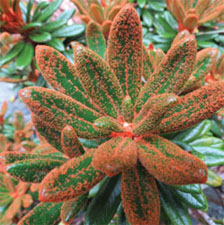
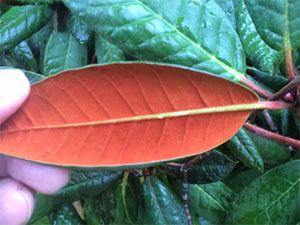
Indumentum (Latin, literally: "garment") is a coating of hairs on the undersides of a leaf. Tomentum is a coating of hairs on the top surface of leaves. Stems and flowers can also be hairy, and this is generally referred as “tomentose”. A plant surface with any kind of hair is said to be “pubescent”.
Indumentum forms a protective, woolly layer that sheds water and/or provides leaf protection. During cold, dry weather, the hairy indumentum that covers the leaf's underside becomes an insulating shield. Some of the plant hairs hold water and absorb it to provide the plant with moisture in times of drought. During times of heavy rain, the hairs are used by the plant to transpire excess water from the surface of the leaf. Indumentum also provides some protection from insect damage.
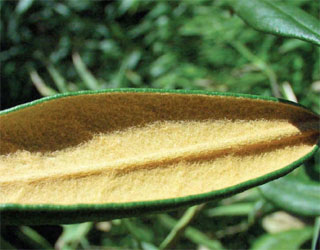
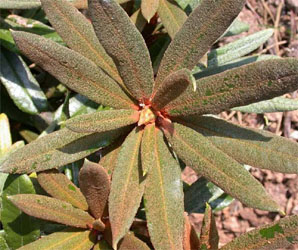
Indumentum types include: Hirsute (hairy, shaggy, long-haired), Pilose (long soft hairs), Villous (shaggy), Stellate (radiating in a star-shape), Scabrous (small projections rough to the touch), and Scurfy (very rough to the touch).
Cardiocrinum giganteum
This summer I've had lots of nice things in bloom, but the plant that made my summer was Cardiocrinum giganteum, as my plant finally bloomed after six years. It was lovely to see and worth the wait.
The first time I saw Cardiocrinum in bloom was in a New Zealand rhododendron garden where it was growing as a companion plant. Well, everything grows in New Zealand, so there were seedlings coming up everywhere as well as having plants in all stages of growth throughout the garden. I remember tip-toeing along a path trying to avoid stepping on plants when the garden's owner said not to worry, they were something of a weed for him. The next time I saw the plant was in its native habitat in the Himalayas. Again, just a spectacular thing and it stuck in my memory as one of those "wouldn't it be nice to try and grow". So, when I was given a one-year old seedling in the spring of 2014 I planted it immediately.
The site I chose gets morning sun, but is shady by early afternoon. Soil is on the heavy side and holds moisture fairly well, only requiring watering towards the end of summer when drought really takes hold. The first couple of years, I put some copper strips around the leaf perimeter to deter any slugs, but by year 3, the plant was strong enough to take care of itself.
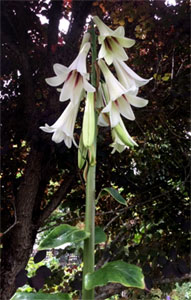
As you can tell from the species name, Cardiocrinum giganteum eventually gets big. The heart-shaped leaves are held on a central upright stem. The stem dies down in the fall and each spring, the new stem grows taller and holds more leaves than the year before. This year, the stem emerged, set out some leaves, as per usual, then it took off and grew vertically fast. There were times I imagined I could actually see it growing. At about 8ft, flower buds formed at the stem apex in June with flowering in July.
Flowers are white flushed with red in the center, trumpet-shaped and spectacular. My plant only had about a dozen flowers, but I've seen pictures where an individual flower stalk has up to 20 or so. Apparently, the bulb can set offsets, so I'll leave everything alone until next summer to see if I'm lucky enough to get some new plants. However, this is one of those plants that blooms once, sets seed and then the old bulb dies. So, I will try to collect some seed and once ripened, I'll try starting some new plants.